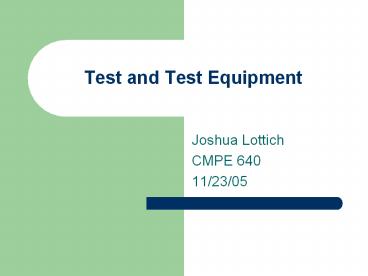Test and Test Equipment - PowerPoint PPT Presentation
Title:
Test and Test Equipment
Description:
Test and Test Equipment Joshua Lottich CMPE 640 11/23/05 Testing Verifies that manufactured chip meets design specifications. Cannot test for every potential defect. – PowerPoint PPT presentation
Number of Views:105
Avg rating:3.0/5.0
Title: Test and Test Equipment
1
Test and Test Equipment
- Joshua Lottich
- CMPE 640
- 11/23/05
2
Testing
- Verifies that manufactured chip meets design
specifications. - Cannot test for every potential defect.
- Modeling defects as faults allows for passing and
failing of chips. - Ideal test would capture all defects and pass
only chips that have no defects. - Driving factor is cost.
3
Design for Testability (DFT) What is it?
- Testing logic is added to a circuit in order to
make testing of the circuit or chip less complex. - The additional circuitry is used only when
testing the circuit and thus issues of area and
performance overhead, power consumption during
testing, and efficiency of the test are
important. - BIST, BISR, SCAN
4
Design for Testability (DFT) Why is it needed?
- Allows for testing of parts of the chip that
would otherwise be untestable or difficult to
test (i.e. sequential logic, hard to control
logic). - Makes the test generation and test application
cost-effective. - The better the DFT approach, the better the test
coverage is, and thus more of the defects will be
detected.
5
Manufacturing Test Cost
- There has been a large increase in the number of
SOC (System-On-Chip) and SIP (System-In-Package)
designs which use a mixture of digital, analog,
RF, and mixed-signal. These chips have created a
demand for an all-in-one test solution that will
reduce the cost of tests for mixed technology
designs. - Problems
- Increasing test costs because these new chips
break the traditional test equipment capability
requirements. - Low-cost equipment solutions targeting DFT
enabled devices do not scale into mixed
technology space. - Solution
- Increase test system configurability and
flexibility, which would be a fundamental shift
in test equipment architecture.
6
High Integration Designs
- Form factor and battery life of consumer products
are driving chip integration. - Large SOC designs will use reusable mixed
technology design blocks, which will enable
designers to put designs together with less
effort. - Problems
- Testing chips containing RF and audio circuits
will be a major challenge if they also contain a
large amount of noisy digital circuitry. - Analog DFT techniques must improve to simplify
test interfacing and slow down test instrument
capability demands. - Highly structured DFT approaches will be needed
to test embedded cores. Each core will require
unique attention when using DFT to enable test. - Solutions
- Analog BIST has been suggested as a possible
solution for testing of mixed-signal designs, but
more research in this area is needed. - DFT must enable test reuse for reusable design
cores to reduce test development time for highly
complex designs.
7
Defects and Failure Mechanisms
- Process technology advancements are changing the
kinds of physical defects which affect circuit
functionality. - Examples
- Smaller vias are more susceptible to incomplete
etch, which possibly leads to a greater number of
resistive vias. - Change from subtractive Al to damascene Cu may
cause metal opens. - Use of low-k dielectrics may increase the number
of resistive bridges. - Changing circuit sensitivities are likely to make
defects that did not previously affect the
circuit capable of disrupting the entire circuit. - Examples
- Shorter clock cycles mean defects that cause 10s
or 100s of picoseconds delays can cause system
failures. - Increasing noise effects such as crosstalk and
power/ground bounce decrease timing and noise
margins making circuit more susceptible to delay
defects. - Important to know about upcoming technology
advancements so that tests, fault models, and
diagnosis tools can be developed that will detect
the defects of future circuits.
8
Reducing Cost of Testing
- Test development time and cost will be reduced
further by DFT techniques, test standards,
automatic generation of test patterns, and
consideration of testability issues earlier in
the design process. - Focus on cost of test will give a better
understanding of the trade-offs between test
methodologies and fault models. - Throughput will be increased through the use of
DFT techniques such as DFT that will allow for
the testing of multiple cores in parallel (ADC,
DAC, digital, memory).
9
Any Questions?































